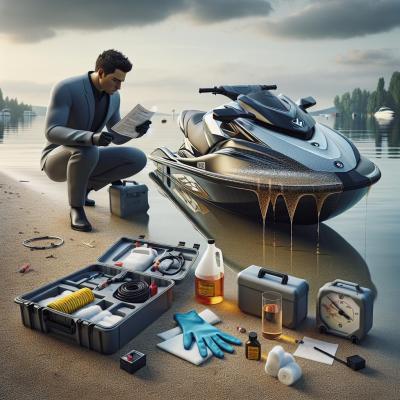Understanding the potential risks and knowing how to handle them is crucial for any jet ski owner. Not only does it contribute to the safety and longevity of your personal watercraft, but it also protects the delicate marine environment we all enjoy. With the right knowledge, you can quickly turn a problematic spill or leak into a minor hiccup on your day out on the water.
In this article, we'll delve into practical and straightforward advice that will help you handle fuel spillage and leaks on your jet ski with confidence. Whether you're new to the sport or have been zipping across the waves for years, you'll find valuable tips and tricks to ensure your time on the water remains unspoiled by such mishaps. Let's dive into the world of 'Leak Lockdown' and secure our adventures for many rides to come.
Understanding the Risks of Fuel Spills and Leaks
Fuel spills and leaks are not only a nuisance but also present considerable environmental hazards. When fuel enters our waterways, it can have devastating effects on the local ecosystem. It spreads quickly across the surface, creating a toxic barrier that can suffocate marine life, damage coral reefs, and disrupt the natural balance. These incidents can further result in long-term contamination of the water, harming wildlife and impacting water quality for recreational use.
Apart from the environmental consequences, fuel spills and leaks pose a significant threat to your jet ski's wellbeing. Engine parts are designed to work in unison, and exposure to unwarranted fuel can corrode and degrade components. This can lead to decreased performance, costly repairs, and even irreversible damage to your precious investment. Other nearby equipment and watercraft are also at risk of being tainted by the spilled fuel, setting a chain of undesirable damage in motion.
Furthermore, being responsible for a fuel spill or leak may attract legal action, depending upon the severity and location of the incident. Regulators take such events seriously, and penalties can range from fines to more severe consequences for repeat or substantial offenses. Financial repercussions can also arise in the form of cleanup costs and potential liability for environmental restoration. It's essential to understand these risks and know how to manage spills and leaks promptly to mitigate the impact.
Pre-Ride Inspection: Your First Line of Defense
Before setting out for a day of heart-pumping fun on your jet ski, it is vital to establish a pre-ride inspection routine. This is your first line of defense against fuel spills and leaks and a critical step to ensure a safe, enjoyable experience on the water. Taking a few minutes to inspect your jet ski can help you identify and prevent issues before they escalate out on the open water.
Begin your inspection with a visual check of the hull for any signs of cracks or damage that may lead to leaks. Any strange odors of fuel can indicate a problem, and a closer examination is warranted. Make sure to review the fuel lines and connections, as these are common areas for leaks to occur, and ensure that all caps and fittings are tight and secure. The fuel tank itself should also be examined for integrity; any signs of corrosion or damage should be addressed immediately.
Don't overlook the importance of examining wear and tear on seals, gaskets, and hoses. These components can deteriorate over time, leading to potential leaks. Keep an eye out for any wet spots or residue around these areas, as this could be a tell-tale sign of a starting leak. By incorporating these checks into your pre-ride routine, you're not just prolonging the life of your jet ski, but also protecting our cherished marine environment from the consequences of fuel spillage and leaks.
Best Practices for Fuel Handling
Safe refueling is a cornerstone of preventing fuel spillage and leaks on your jet ski. The goal is to be efficient, clean, and environmentally cautious each time you fill up your tank. Start by always refueling on land to minimize the chances of spills reaching the water. Ensure your jet ski is on a stable surface and the engine is cool before you begin. Use a spill-proof portable fuel container with an automatic shut-off nozzle to avoid overfilling and spillage.
Regarding fuel containers and transfer methods, opt for those specifically designed for marine use. These fuel containers are typically more robust and come equipped with features to mitigate spills. Remember to fill the containers slowly and leave some air space to allow for expansion. A funnel with a built-in filter can also be a valuable tool to help avoid spillage and ensure that no debris enters the fuel system during transfer.
When it comes to storage, both the fuel and the jet ski need careful attention. Store fuel containers in a cool, well-ventilated area away from any potential sources of heat or sparks. For the jet ski itself, choose a well-ventilated storage area, preferably with a catch basin or absorbent pads underneath as a precaution against potential leaks. By following these best practices, you become a proactive guardian of both your jet ski and the environment, ensuring that your aquatic adventures leave only positive ripples behind.
On-the-Water Leak Detection: Staying Alert
Enjoying the thrill of jet skiing also means being vigilant for any signs of trouble, such as fuel leaks. When you're gliding across the water, paying attention to your jet ski's performance and condition is essential. Recognizing the warning signs can be the difference between a minor issue and a potential emergency.
To stay alert on the water, keep an eye out for an unexpected drop in power or performance, which can indicate a fuel system issue. A strong smell of fuel or visible sheen on the water's surface around your jet ski are telling signs of a leak. Additionally, any irregular sounds coming from the engine, such as spluttering or popping, should prompt you to investigate further.
Immediate Actions After Leak Detection
If you detect a leak or spill, your response should be immediate and mindful to prevent escalation. First, shut off the engine to reduce the risk of fire and further leakage. Signal for help if you're riding with others or use your communication devices to alert nearby vessels or shore assistance.
After shutting down the engine, inspect the source of the leak if safely possible. Secure any loose fuel lines or caps that may have come undone, taking care to avoid contact with the fuel. These temporary fixes could help minimize the leak as you head back to shore.
Navigating Back to Shore Safely
Returning to shore with a leak needs to be done cautiously to ensure your safety and that of others. If the jet ski is still operational and the leak is contained, proceed at a slow speed to reduce the amount of fuel being pumped and minimize wake disturbances. If you cannot operate the jet ski, signaling for a tow or assistance from other watercrafts is the safest option.
Always keep the wind direction in mind, as it can carry fuel away from the leak area and reduce the risk of ignition. Make your way to the nearest accessible point, all the while being prepared to evacuate the jet ski should the situation worsen. Remember, your safety is paramount, and your jet ski should take a backseat to personal well-being.
Emergency Spill Kits: What You Need and How to Use Them
Preparedness is key when it comes to handling unexpected fuel spills and leaks. Having an emergency spill kit on your jet ski can make a significant difference in mitigating the damage caused by fuel in the water. This kit should be compact, easily accessible, and contain all the essentials needed to tackle a fuel-related mishap efficiently.
Essential Components of an Emergency Spill Kit
Your spill kit should include absorbent pads and booms designed specifically for fuel containment. These materials are hydrophobic, which means they repel water but absorb oils and fuels, making them particularly effective. Disposable gloves and safety goggles are also critical for personal protection during cleanup. Additionally, include a sturdy trash bag to safely dispose of used materials and seal away contaminants. Lastly, a set of basic tools and spare parts like hose clamps, duct tape, and screwdrivers can help manage and repair minor leaks on the spot.
Effectively Using Each Item in Your Spill Kit
-
Upon discovering a spill, don safety goggles and gloves to protect your eyes and skin from any hazardous materials.
-
Deploy absorbent pads and booms immediately, placing them around and over the spill to start absorbing the fuel. Ensure they are fully saturated before replacement to maximize effectiveness.
-
Use the tools and spare parts to attempt a temporary repair of any apparent leaks. Tighten any loose connections or apply duct tape to temporarily seal small cracks or holes in the hull or fuel line.
-
Once the spill is contained and you've made temporary repairs, place all used and contaminated absorbents into the trash bag. Seal it to prevent any leakage during transport.
Keeping a Kit on Your Jet Ski
It's not just about having an emergency spill kit; it's also about ensuring it's always on your jet ski. The unpredictability of spills and leaks means you must be ready at all times, whether close to shore or out in open water. Store your spill kit in an easily reachable location on the jet ski, preferably in a waterproof compartment or container to keep the components dry and ready for use. Regularly check the kit for completeness and replace any used or expired items to maintain its readiness.
Remember, while an emergency spill kit is a necessary tool, preventing spills through proper maintenance and handling remains the best strategy. However, in the event of an accident, your spill kit can greatly reduce environmental damage and help protect the waters we all enjoy.
Cleaning Up After a Spill: Do’s and Don’ts
Immediate Steps for Containing and Cleaning Up a Spill
When dealing with a fuel spill on your jet ski, quick action can prevent the situation from worsening. The first step is to assess the size and scope of the spill. Be aware of your environment, including the water conditions and proximity to land or other watercraft.
Control the spill by surrounding it with absorbent booms. This helps to contain the fuel, making subsequent clean-up efforts more manageable. Concurrently, use the absorbent pads to begin soaking up the fuel. Always work from the outside inward to avoid spreading the fuel further.
Try to de-escalate any ignition sources in the area. Although jet ski fuel systems are sealed, it's still best to turn off the engine and electrical systems as a precaution.
Importance of Proper Disposal of Contaminated Materials
Disposal of materials used in fuel spill clean-up should be done properly to avoid secondary contamination. Contaminated absorbents can leak into the environment if not handled correctly. Seal them in sturdy, leak-proof bags or containers.
Consult local environmental guidelines to correctly dispose of hazardous waste. Improper disposal could result in both environmental damage and legal penalties, so follow regulations diligently.
Follow-up Actions to Prevent Future Leaks
Once you've managed the immediate threat, it's essential to identify the leak's cause to prevent future incidents. Inspect the jet ski thoroughly for damaged fuel lines, tank issues, or deteriorated components that may need replacing.
Consider a professional inspection to diagnose and repair any complex issues that may not be immediately apparent to the untrained eye. Implementing a regular maintenance schedule will help identify potential problems before they lead to another spill.
Finally, educate yourself further on fuel system management and regularly review and update your practices accordingly. Learning from each incident strengthens your ability to avoid repeats in the future, ensuring your jet skiing experiences are both fun and environmentally responsible.
Maintenance Tips to Prevent Future Leaks
It is often said that prevention is the best cure, and this certainly holds true for avoiding fuel leaks on your jet ski. Proper maintenance not only enhances the lifespan of your jet ski but also maintains its performance and ensures your time on the water is safe and uninterrupted. Following a structured maintenance routine minimizes the risk of leaks and helps to catch any issues before they escalate to a spill or environmental hazard.
Maintenance Checklist Specific to Jet Ski Fuel Systems
-
Inspect the fuel lines for signs of wear, cracking, or brittleness. Replace any damaged lines promptly.
-
Check fuel line connections and clamps to ensure they are secure and there are no signs of leakage.
-
Examine the fuel tank for any corrosion, dents, or damage, especially after an impact or collision.
-
Regularly inspect and replace, if necessary, the fuel cap seal to ensure it's airtight and prevents leakage.
-
Maintain the integrity of gaskets and seals in the fuel system and replace them at any sign of deterioration.
Regular Maintenance Intervals
Like any other vehicle, a jet ski requires regular maintenance to ensure its proper functioning. A consistent maintenance schedule should be adhered to, ideally at the beginning and end of each riding season. During the season, a monthly inspection of the fuel system can catch potential problems before they develop into leaks. After an especially rigorous day on the water or any incidents, it's wise to perform a quick check of critical fuel system components.
Professional Inspections and When to Seek Expert Help
While regular self-inspections play a critical role in leak prevention, there's no substitute for professional expertise. Annual inspections by a qualified technician are highly recommended. A professional can offer a more thorough checkup of your jet ski's systems, including pressure testing the fuel system, which may reveal issues not easily spotted by a visual inspection.
Should you notice persistent issues such as a smell of fuel after performing standard maintenance, or after previously addressing potential leaks, seek out an expert. Similarly, after any collisions or significant impacts, a professional inspection can ensure that nothing has been compromised within the fuel system. Proactive visits to the mechanic not only extend your jet ski's life but also ensure your peace of mind while you're cruising the waves.
Conclusion
Throughout this journey, we have navigated the ins and outs of managing fuel spillage and leaks on your jet ski, emphasizing the critical role of awareness and prevention. Armed with the knowledge from this article, you hold the keys to not only averting potential environmental disasters but also protecting your valuable watercraft from damage.
Understanding the risks and the steps you can take before, during, and after any spillage can make the difference between a quick cleanup and a serious incident. From incorporating comprehensive pre-ride inspections to equipping yourself with an emergency spill kit, these precautions embody the core values of responsible jet skiing. It is our shared duty to act as guardians of the waterways we cherish, ensuring they remain pristine for future generations of enthusiasts and marine life alike.
We invite you to remain vigilant, stay prepared, and always prioritize safety in your aquatic adventures. If you have encountered fuel-related issues on the water or have developed unique strategies to handle such situations, your knowledge is invaluable. Share your own experiences and insights in the comments below or on our community forum. By exchanging our stories and tips, we cultivate a culture of care and respect for our passion and our environment. Let's continue to ride the waves with confidence and a deep sense of responsibility.
Published: Wednesday 14th February, 2024
Last updated: Sunday 7th January, 2024









